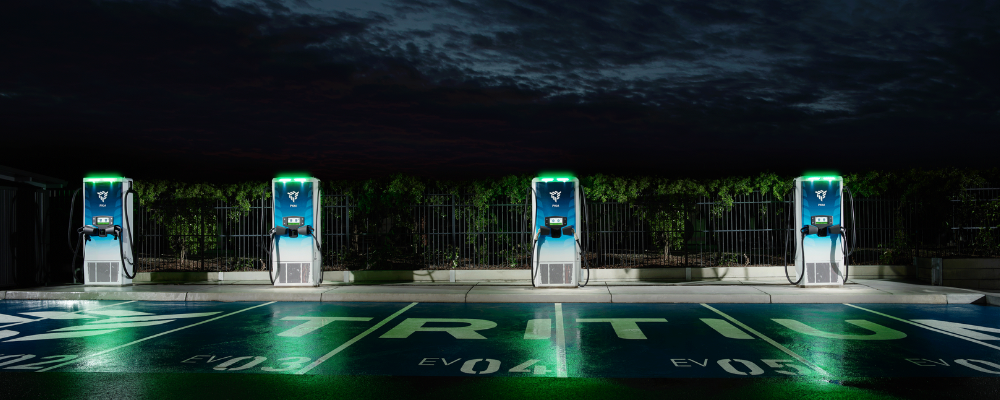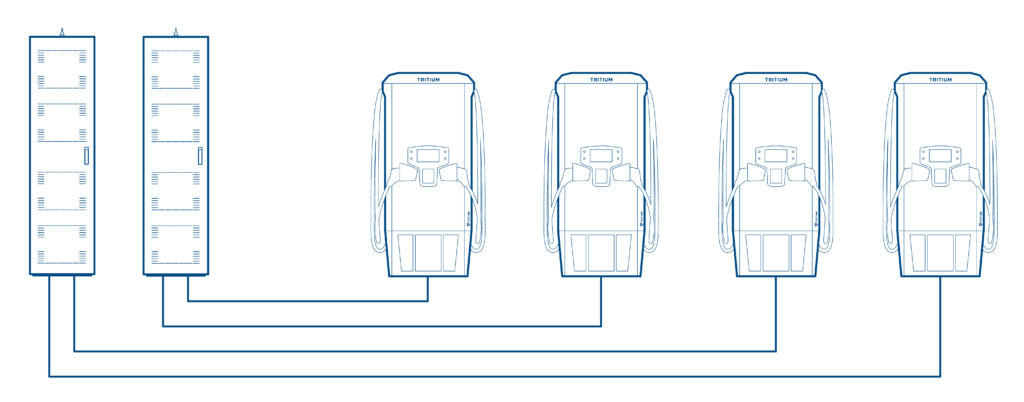What is NEVI and how will it help electrify American transportation?

Updated February 2023
In November 2021, President Biden signed the Infrastructure Investment and Jobs Act (Bipartisan Infrastructure Law), which provides $1.2 trillion for roads, bridges, mass transit, and other projects through 2026. The National Electric Vehicle Infrastructure (NEVI) Formula Program is part of that bill and provides $5 billion in funding to help build a coast-to-coast network of direct current (DC) fast chargers. All 50 states, Washington DC, and Puerto Rico are participating in the NEVI program, which will electrify more than 75,000 miles of the national highway system.
What are the NEVI requirements for charging infrastructure?
The Federal Highway Administration (FHWA) announced new national standards for federally funded EV chargers on February 15, 2023. These standards define requirements for connector types, payment methods, data privacy, speed and power of chargers, reliability, and the overall charging experience.
Here are some general standards for the public charging network built with NEVI funding:
- Predictable charging: Consistent plug types, power levels, and a minimum number of chargers capable of supporting drivers’ fast charging needs
- Reliability requirements: 97% uptime reliability requirement
- Accessible charging: Publicly accessible data on charging locations that include price, availability, and accessibility through mapping applications
- Single ID: A single method of identification that works across all chargers
- Plug & Charge capability: All NEVI chargers must support Plug & Charge.
Buy America Requirements
In addition, chargers purchased and installed with NEVI and Discretionary Grants funds must meet FHWA Buy America standards, which ensure key components are made in America and chargers are assembled in America. Buy America standards include:
- Assembly: EV chargers and all components must be assembled in the US.
- Steel components: Housing components that are predominantly steel and iron must comply with existing FHWA Buy America steel and iron requirements, meaning that if predominantly iron and steel housing is used for the EV charger, the housing must be entirely manufactured in the United States according to FHWA standards. This includes all manufacturing processes for the EV chargers housing, from melting and pouring through the final application of coatings.
- Domestic content: Beginning July 1, 2024, at least 55% of the components (by cost) used in charging equipment must meet Build America, Buy America Act standards as well as final assembly in the U.S. Any equipment that does not meet this standard must be installed no later than October 1, 2024.
- The final waiver instead uses the date on which an EV charger is manufactured instead of installation date. The FHWA considers the “date of manufacture” to be the date on which the EV charger, as defined further below, has its final assembly occur and is in an operational state.
- The definition of “EV charger” as used in this final waiver only refers to the self-contained EV charging unit; it does not include associated equipment.
Lastly, the FHWA and the Biden administration are encouraging manufacturers and installers to work with the Electric Vehicle Infrastructure Training Program (EVITP). Through the White House Talent Pipeline Challenge (Tritium is a participant), the International Brotherhood of Electrical Workers (IBEW) has certified 20,000 electricians through EVITP.
Are there other NEVI requirements for charging infrastructure?
The FHWA and US Department of Transportation have posted a final rule that establishes regulations setting minimum standards and requirements for NEVI-funded charging sites. These requirements cover everything from installation to data connections. The full list can be found on the US government website here, but here are some of the most important requirements:
- Chargers must meet Buy America standards (see above).
- EV charging stations must be deployed every 50 miles and within one mile of the state’s portion of the interstate highway system, creating a coast-to-coast network for drivers.
- Each station must be capable of charging four EVs at 150kW and have a total minimum charging capacity of 600kW.
- Each charging port must be able to charge any CCS-compliant vehicle and must have at least one permanently attached CCS Type 1 connector.
- Permanently attached non-proprietary connectors (such as Tesla’s NACS) are allowed as long as each charging station has at least one permanently attached CCS Type 1 connector and is. capable of charging a CCS-compliant vehicle.
- Permanently attached CHAdeMO connectors can be provided using only FY2022 NEVI Funds.
- DCFC charging ports must support output voltages between 250 volts DC and 920 volts DC.
- Each port must maintain 97% uptime and must be operational and maintained for a minimum of five years.[TP1] [TP2]
- A charging port is considered “up” when its hardware and software are both online and available for use, or in use, and the charging port successfully dispenses electricity in accordance with requirements for minimum power level.
- Charging port uptime must be calculated on a monthly basis for the previous twelve months.
- Uptime is calculated based on outages in minutes.
- The final rule revises uptime calculations to clarify exclusions for the uptime calculation including additional exclusions for scheduled maintenance, vandalism, natural disasters, and limited hours of operation.
- FHWA upheld the calculation in the final rule remaining at a per-port level.
- FHWA also modified the requirements for data reporting under § 680.112(b) to collect error code data to better understand the nature and frequency of charging session problems.
- Charging sites must have secure payment methods—card readers, tap-to-pay, etc.[TP3]
- Charging stations must provide a contactless payment method that accepts major credit and debit cards and accept payment through either an automated toll-free phone number or SMS message.
- Payment methods must be accessible to persons with disabilities, not require a membership, not affect the power flow to vehicles, and provide access for those that are limited English proficiency.
- Charging sites must accommodate disabled drivers according to the Americans with Disabilities Act (ADA).
- Charging stations located along and designed to serve users of designated Alternative Fuel Corridors must be available for use and sited at locations physically accessible to the public 24 hours per day, 7 days per week, year-round.
- Once a state has constructed the required number of chargers on designated Alternative Fuel Corridors, it can fund charging sites on other highways and within cities with any funds remaining. They can also add more chargers (at lower power levels) to existing sites to increase capacity and reliability.[TP4] The federal government will cover up to 80 percent of project costs—the remaining must be funded privately or by the state.
- Additional flexibility is provided for projects that are not located along alternative fuel corridors, including the flexibility to install AC Level 2 chargers and DC fast chargers at lower power levels.
- This final rule enables States or other designated recipients to implement federally funded charging station projects in a standardized fashion to build a convenient, accessible, reliable, and equitable charging network across the country that can be used by all EVs regardless of brand.
- Each charging port must have an average annual uptime of greater than 97%.
- A charging port is considered “up” when its hardware and software are both online and available for use, or in use, and the charging port successfully dispenses electricity in accordance with requirements for minimum power level.
- Charging port uptime must be calculated on a monthly basis for the previous twelve months.
- Uptime is calculated based on outages in minutes.
- The final rule revises uptime calculations to clarify exclusions for the uptime calculation including additional exclusions for scheduled maintenance, vandalism, natural disasters, and limited hours of operation.
- FHWA upheld the calculation in the final rule remaining at a per-port level.
- FHWA also modified the requirements for data reporting under § 680.112(b) to collect error code data to better understand the nature and frequency of charging session problems.
Altogether, the vast network of charging sites will be able to charge millions of EVs and help move the US to a cleaner, electrified future. “A century ago, America ushered in the modern automotive era; now America must lead the electric vehicle revolution,” said US Department of Transportation Secretary Pete Buttigieg at a press event. “The President’s Bipartisan Infrastructure Law will help us win the EV race by working with states, labor, and the private sector to deploy a historic nationwide charging network that will make EV charging accessible for more Americans.”
According to consulting firm The Brattle Group, there could be as many as 35 million EVs in the US by 2030, and those vehicles will need up to 2 million public chargers. NEVI will give states the funds to purchase and install those chargers, but it’s up to the EV charging industry to build and install them.
Tritium is opening a manufacturing facility in Tennessee that is expected to be capable of producing more than 10,000 DC fast chargers per year, with the potential to produce about 30,000 units per year at peak capacity. The facility will employ more than 500 people over the next five years and chargers produced in the facility should meet FWHA Buy America requirements starting in the first quarter of 2023.
How does Tritium meet NEVI requirements?
Tritium’s current NEVI solution consists of four PKM150 150kW chargers with two power rectifier units. The chargers deliver 150kW of power to four EVs simultaneously through a reliable, easily upgradeable on-site charging infrastructure.

Thanks to multiple chargers and power rectifier units, the Tritium NEVI solution provides backup charging power for higher reliability and site uptime.
PKM150 NEVI-Compliant Features
- Modular design for reliability, serviceability, and upgradeability
- Sealed IP65-rated enclosure
- CCS (up to 920V/180A DC), CHAdeMo available
- ISO15118 “Plug and Charge” ready
- 3G / 4G wireless communication and wired ethernet
- Secure, contactless credit card reader
- Multiple language support
- Surge protection devices on AC and DC links
- Front and back LED lighting
- 20-foot cables with management system
- ADA compliant
- Small footprint – 79″ x 34″ x 12″
Navigating NEVI
Many US states will start receiving NEVI funds in Q4 2022 and they’ll be looking for NEVI-compliant charging solutions. Whether you’re a state agency, EV charger reseller, charger installer, or charging site planner, you’ll need help navigating NEVI requirements. Reach out to our experts to learn more about building and deploying NEVI-compliant DC fast charging sites.